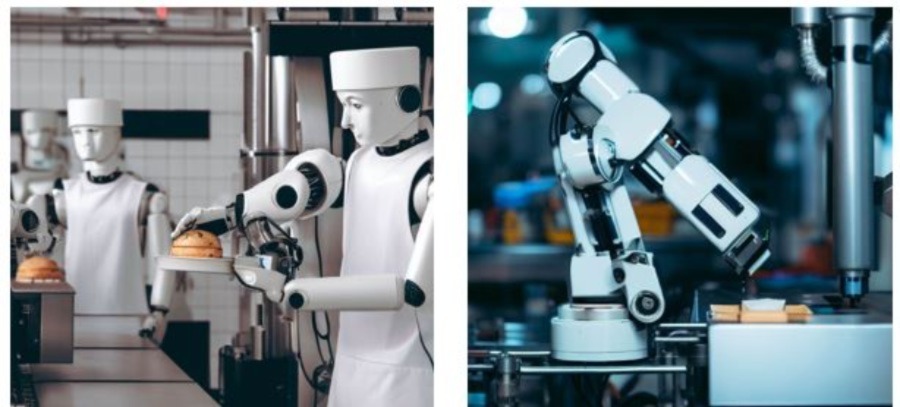Food robotics
Food robotics is the application of robots and automation in the food industry by manufacturers. From packing to meat processing, companies have started to deploy robotics in almost every process, replacing manual workers. The use of robotics in the food and beverage industry is booming right now. Manufacturers are increasingly turning to robotic automation to help keep up with the rapidly changing consumer habits around food and beverage consumption. (Source: https://blog.robotiq.com/robotics-in-the-food-and-beverage-industry-whats-new-in-2022)
Some of the top trends in food robotics include dark kitchens, cobot’s applications, and robotic meat cutting. Dark kitchens are optimized for delivery rather than for seated customers or conventional takeaway. Robots can be used anywhere from packing and palletizing all the way to food preparation itself in fully automated dark kitchens. Robotic meat cutting is still a rare application in North America, but is more common in Europe. (Source: https://www.automate.org/industry-insights/food-robotics)
The first use of robots in food processing was primarily for packaging and palletizing operations. According to the International Federation of Robots, 240,000 units were sold worldwide in 20151. (Source: https://www.ift.org/news-and-publications/food-technology-magazine/issues/2017/october/columns/processing-robotics-food-beverage-processing-foodservice)
In 1998, flex picker robots were introduced, revolutionizing the food industry by enabling rapid picking and placing of food items. Robots are now being used in many food processing operations from farm to fork. Food industry manufacturers have reported a 25% increase in productivity since employing robotics when compared to the work done by humans.
Meat Processing
Meat processing is a labor-intensive industry with many tasks that can be challenging and sometimes dangerous for human workers. The use of robots in meat processing has been growing rapidly in recent years due to advancements in automation technology, which enables machines to perform tasks traditionally done by humans. Let’s elaborate on some of the technical details of how robots are being utilized in different aspects of meat processing:
- Working in Freezers: Working in low-temperature environments like freezers can be hazardous for humans due to the risk of frostbite and other cold-related injuries. Robots equipped with specialized materials and components designed to withstand extreme cold temperatures are employed in these environments. They can efficiently perform tasks such as sorting and palletizing meat products without any negative impact on their performance or health.
- Cutting Carcasses: Robots equipped with advanced vision systems and precise cutting tools are used for cutting carcasses into specific portions. These vision systems allow the robots to identify and track the shape and orientation of the carcass, ensuring accurate cuts and minimizing waste. Additionally, these robots can adapt to variations in size and shape of different animals, making them versatile and efficient for various meat processing applications.
- Deboning Chickens: Deboning chickens is a delicate task that requires precision and dexterity, making it challenging for manual labor in terms of speed and consistency. Robotic deboning systems use advanced gripping mechanisms, combined with computer vision and machine learning algorithms, to locate and separate the meat from the bones accurately. These robots can process a large number of chickens in a short time while minimizing waste and increasing yield.
Dairy Processing
Dairy processing is another industry that has embraced automation and robotics to improve efficiency, product quality, and overall production. In addition to automatic milking systems, robots are being utilized in various stages of cheese processing, such as stirring curds and slicing cheese. Let’s delve into the technical details of how robots are employed in these specific tasks:
Stirring Curds: Cheese-making involves a critical step called “stirring curds,” which plays a vital role in determining the texture and consistency of the final cheese product. Traditional cheese-making required manual labor, which was time-consuming and could introduce inconsistencies in the process. Robotic systems have been developed to address these challenges.
Robotic curd stirrers are equipped with precise motor control and programmed motion patterns to gently agitate the curds at specific intervals and intensities. The motion of the robot is designed to mimic the hand-stirring motion that cheesemakers traditionally used, ensuring uniform mixing and preventing curds from sticking together. Additionally, sensors can monitor temperature and acidity levels, adjusting the stirring process to achieve the desired cheese characteristics.
Slicing Cheese: Cheese slicing is a repetitive and delicate task that requires consistent thickness and accuracy to meet market standards. Robots used for cheese slicing are equipped with advanced imaging systems to assess the size, shape, and orientation of each cheese block before slicing. This allows the robot to adapt to variations in cheese dimensions, ensuring precise and uniform slices.
Robotic cheese slicers use high-speed, high-precision cutting tools, such as waterjet cutters or laser cutters, to achieve the desired slice thickness without compromising the integrity of the cheese. The automation of this process not only improves accuracy but also increases production throughput, reducing the need for manual labor and human intervention.
Quality Control: In both milking systems and cheese processing, robots play a crucial role in quality control. Sensors and cameras are used to assess various parameters, such as milk quality, curd texture, cheese color, and uniformity of slices. These data are fed into the control system, allowing the robots to make real-time adjustments to maintain consistent quality.
There are several challenges and disadvantages associated with the use of robots in food processing. One of the main challenges is the development of robotic end-effectors to cope with large variations of food products with high practicality and low cost.
Another challenge is the recognition of food products and materials in 3D scenarios, as well as a better understanding of the fundamental information of food products, including food categorization and physical properties from the viewpoint of robotic handling.
Additionally, there are concerns about human error when operating robots, which has played a role in the limited growth of food and beverage industrial robots. Another drawback is the social concern around the use of robots, as well as the significant investment required in terms of installation and maintenance. (Source: https://www.fooddive.com/news/pros-and-cons-of-adopting-industrial-robotics-in-food-beverage-industry/416379/)

